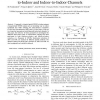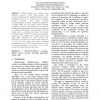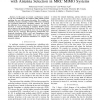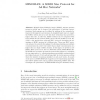104
click to vote
VTC
2010
IEEE
14 years 11 months ago
2010
IEEE
- Compared to classical spatial MIMO wireless systems, cross-polarized MIMO systems are an interesting way to reduce equipment size while reducing the inter-antenna correlation. Cr...
110
Voted
VTC
2010
IEEE
14 years 11 months ago
2010
IEEE
—This work presents results for wireless outdoor MIMO transmission experiments at 2.68 GHz, which were conducted in an urban residential area, using realistic handset and base st...
112
click to vote
CORR
2008
Springer
14 years 11 months ago
2008
Springer
Multiple-input multiple-output (MIMO) systems are being considered as one of the key enabling technologies for future wireless networks. However, the decrease in capacity due to th...
93
Voted
TIT
1998
15 years 8 days ago
1998
—In this paper, we investigate adaptive blind source separation and equalization for multiple-input/multiple-output (MIMO) systems. We first analyze the convergence of the const...
113
click to vote
JSAC
2006
15 years 17 days ago
2006
4G systems are expected to support data rates of the order of 100 Mbps in the outdoor environment and 1 Gbps in the indoor/stationary environment. In order to support such large p...
95
Voted
CORR
2007
Springer
15 years 18 days ago
2007
Springer
In this paper, the inherent drawbacks of the naive lattice decoding for MIMO fading systems is investigated. We show that using the naive lattice decoding for MIMO systems has con...
112
click to vote
ERSA
2006
15 years 2 months ago
2006
MIMO systems have attracted great attentions because of their huge capacity. The hardware implementation of MIMO decoder becomes a challenging task as the complexity of the MIMO sy...
87
Voted
GLOBECOM
2009
IEEE
15 years 3 months ago
2009
IEEE
— In this paper, we present a performance analysis for the user scheduling for the multiuser MRC MIMO systems exploiting the user and antenna diversities. We consider two schedul...
141
click to vote
ADHOCNOW
2005
Springer
15 years 6 months ago
2005
Springer
Multiple-Input Multiple-Output (MIMO) antenna systems present a radical way to improve the performance of wireless communications. Such systems can be utilized in wireless ad hoc n...
97
Voted
VTC
2007
IEEE
15 years 6 months ago
2007
IEEE
— MIMO systems are of interest to meet the expected demands for higher data rates and lower delays in future wireless




